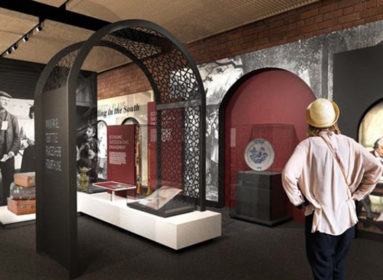
New book tells the story of two young Jewish women…and the assassination of Leon Trotsky
By Judie Jacobson
 In 2005, Roberta Satow Wool was vacationing in Mexico with her husband when she happened upon a fascinating story about Marxist revolutionary Leon Trotsky. The story led Satow Wool to pen her first work of fiction, Two Sisters of Coyoacan.
In 2005, Roberta Satow Wool was vacationing in Mexico with her husband when she happened upon a fascinating story about Marxist revolutionary Leon Trotsky. The story led Satow Wool to pen her first work of fiction, Two Sisters of Coyoacan.
Based on a true story, Two Sisters of Coyoacan follows the life of Gertie and Lilly Abramovits, two young Jewish women from Brooklyn, New York, whose parents, like many American Jews, supported the overthrow of the Czarist regime by the Bolsheviks in 1917. The two well-meaning sisters unknowingly become entangled in a plot conceived by Stalin to eliminate a powerful enemy.
Set in the 1930’s when antisemitism, economic insecurity, and restrictive immigration laws were barriers to Jewish refugees seeking safe haven in the United States, Two Sisters of Coyoacan explores an early example of the degree to which Russian leaders (Stalin, Putin) will go to control their enemies through the use of naïve “collaborators.”
Satow Wool, who has been a “weekender” in the Connecticut town of Washington for many years, is a psychoanalyst and the author of several books of non-fiction, including Doing the Right Thing: Taking Care of Your Elderly Parents Even if They Didn’t Take Care of You. She also writes a blog for Psychology Today.
She will discuss her new book at the Gunn Memorial Library in Washington, Connecticut on Thursday evening, August 24.
Recently, Satow Wool talked about her new book with the Ledger.
JEWISH LEDGER (JL): Tell us a little bit about yourself.
ROBERTA SATOW WOOL (RSW): I was born in Brooklyn, [New York], lived in a Jewish neighborhood and assumed the whole world used Yiddish expressions until I went to college at the University of California at Berkeley and found out that Jews are a tiny minority of Americans. Whenever I used a Yiddish expression people looked nonplussed. I came back to Brooklyn after college and became a professor of sociology at Brooklyn College and the Graduate Center of the City University of New York. I am also a psychoanalyst and write a blog for Psychology Today: ttps://www.psychologytoday.com/blog/life-after-50/.
JL: The book is described as being “based on a true story.” Just how “true” is it?
RSW: The novel is historical fiction. The two sisters in the title – Lilly and Gertie Abramovitz – were based on Ruth and Sylvia Ageloff. They were the daughters of a wealthy Brooklyn real estate developer, Samuel Ageloff, who is the model for Tateh in the novel. Ruth was Leon Trotsky’s secretary in 1936-37. The NKVD [The People’s Commissariat for Internal Affairs, which was the leading Soviet secret police organization from 1934 to 1946], trained an agent to seduce her sister Sylvia in order to gain entry into Trotsky’s house to assassinate him.
The events in the novel are based on real events, however, fictional characters mingle with historical figures. Some incidents and all dialogue is imagined. Minor alterations were also made in the timing and placement of persons and events for literary purposes.
JL: This is not a well known story – how did you happen upon it and what prompted you to write the book?
RSW: In 2005, my husband, Richard Wool, and I visited Frida Kahlo’s house (which is now a museum) in Coyoacán which is a suburb of Mexico City. Trotsky lived at Kahlo’s house during and after the proceedings of the Commission of Inquiry into the Charges Made Against Leon Trotsky in the Moscow Trials that was chaired by John Dewey. The docent explained that there was an unsuccessful attempt by Mexican Stalinists to murder Trotsky in May 1940 and he was finally assassinated because the sister of his American secretary was seduced by a Stalinist agent and she gave him access to Trotsky.
Later, in 2009, a colleague called my attention to the fact that Ruth Ageloff Poulos, a psychoanalyst who was affiliated with the same institute that I am, had been Trotsky’s secretary in the 1930s. It was her sister who was seduced by Ramon Mercader in order to gain access to Trotsky. That connection prompted me to write the novel.
JL: How does the sisters’ Jewish background figure into the story?
RSW: The main characters are Jewish and it explores Jewish radical politics in the 1930s. The novel begins in Brownsville that had the largest population of Jews in New York City at the time. Many American Jews supported the overthrow of the Czarist regime in 1917. Some were left-leaning, but most simply hated the Czar. In the early 1930’s, the sons of Jewish immigrants argued about the virtues of Trotsky vs. Stalin at places like City College in New York while Hitler became Chancellor of Germany. From 1933 to the Moscow trials, splits deepened between Stalinists and Trotskyists. Later, as a result of the Stalin-Hitler pact and entry into the Second World War many of them turned away from radicalism.
In the novel, Lilly confronts Trotsky about his view that fascism is just a form of capitalism; his lack of identification as a Jew; and his lack of outrage about the Stalin-Hitler non-aggression pact in 1939. Many western European and American communists were disgusted and left the party.
JL: Is there a lesson to be learned here? A message you hope the audience will take away?
RSW: I don’t really think a novel should have a message. But, one major theme of the novel is articulated by Lilly’s father. Tateh tells her, “You have to be careful not to let ideas become more important than people.”
Book talk & signing with author Roberta Satow Wool: Thursday, August 24, 6:30 p.m., Gunn Memorial Library, 5 Wykeham Rd, Washington, Conn. For information: (860) 868-7586, www.gunnlibrary.org.








 Southern New England Jewish Ledger
Southern New England Jewish Ledger










